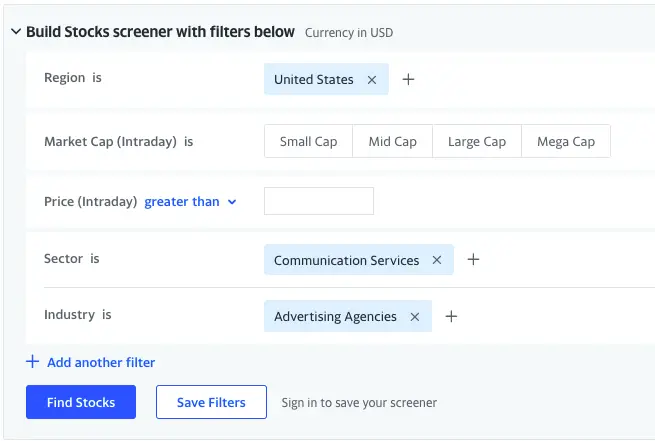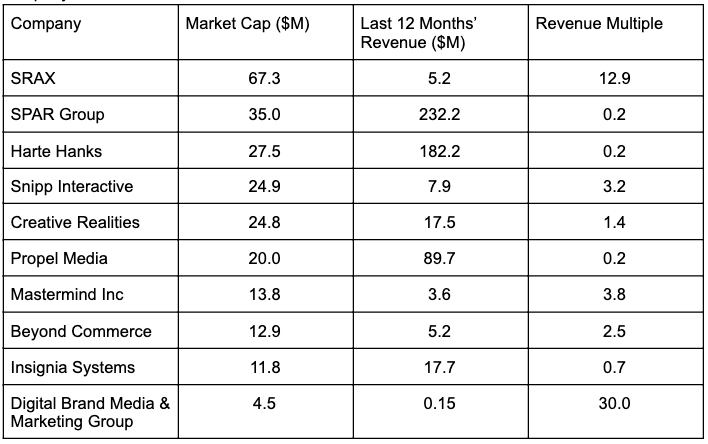Here is a step by step guide on how to value a company based on revenue. You can value any company, whether it’s big or small, public or private, for any industry, using this method.
Note that when you value a company based on revenue, it’s not looking at the fundamentals of the whole business, so the valuation is over-simplified and may not reflect the true valuation of the company.
That being said, it is a quick and dirty valuation method, and you should always use this method with caution and do further diligence.
How To Value A Company Based On Revenue – Step By Step Guide
Below are the 7 simple steps to follow on how to value a company based on revenue.
- Determine which industry the company you want to value is in.
- Search which competitors (or closest competing companies available) are public in this industry.
- Look up 10 of these companies’ revenue and their market cap.
- Calculate the average revenue multiple of these public companies by dividing market cap by their last 12 months’ revenue.
- Make adjustments to the multiple (from step 4) depending on the size of your subject company compared to your sample set.
- Determine the last 12 months’ revenue of your subject company.
- Multiply the average revenue multiple (from step 6) to the revenue of your subject company.
Now, here is an example of how I would use the above steps to value a company based on revenue.
How To Value A Company Based on Revenue – Example
Example Description:
Let’s pick a private company as our first example. Scroll down to see the same step by step example using a public company.
For my example company, let’s say it’s a 10-people marketing agency, and the company generated about $2 million every year for the last 3 years, but this year, they’re on track to generate over $5 million in revenue.
So, now let’s answer the 7 questions step by step to value this private company based on revenue.
Step 1: Determine which industry the company you want to value is in.
The company I want to value is a private company and the industry is marketing, and more specifically, an agency that provides marketing services.
Step 2: Search which competitors (or closest competing companies available) are public in this industry.
A quick way to get the first list of companies in this industry is to use a free company screener available. A great free public company screener is Yahoo.
Now here, I choose the sector first, and then the industry. There isn’t “marketing” as an industry, but the closest is advertising agencies, so I will choose that.
I will also choose “small cap” since my example company is making less than $10 million a year.
The screener search page looks like this:

The search result gives me a list of 86 companies, but it’s not the greatest (which is expected from a free tool), but we can still work with it.
From the result, I’m going to pick 10 companies with the smallest market cap and revenue amount and with business descriptions that sound the most relevant to marketing agencies.
You can google the company in the list to see what that business does.
Step 3: Look up 10 of these companies’ revenue and their market cap.
I picked these 10 companies from the result and made sure they were in the same relevant industry. In the Yahoo Finance result view, I have their market cap, so now I will look up each company’s revenue:

Step 4: Calculate the average revenue multiple of these public companies.
Surprisingly, the revenue multiples for the most part are pretty small. But, I’m going to get rid of the outliers, which for their own idiosyncratic reasons, have a much higher multiple than the rest of the data set.
Once I remove the SRAX and Digital Brand Media & Marketing Group (since their multiples are egregious), then I get:
- Average revenue multiple of 1.5x and
- Median revenue multiple of 1.0x.
Let’s be on the conservative side and choose to use the median revenue multiple of 1.0x.
Step 5: Make adjustments to the multiple (from step 4) depending on the size of your subject company compared to your sample set.
Private companies tend to get a discount in their valuation, mainly because they have less access to capital, since they can’t do a public offering and they’re not widely known by the public.
But in this case, because the average and median revenue multiple of the public companies in the same industry is already quite low, and it’s a little all over the place, we won’t make any further adjustments.
We will stick to using the revenue multiple of 1.0x.
Step 6: Determine the last 12 months’ revenue of your subject company.
In the beginning of this example, I gave you 2 numbers related to the company’s revenues. It’s very important to use the revenue number of the same period as the data set.
The public companies above show the last 12 months’ revenue, so we must use the same last 12 months’ revenue of the subject company, which is $2 million.
Step 7: Multiply the average revenue multiple (from step 6) to the revenue of your subject company.
Now, we have everything we need. We multiply the revenue multiple of 1.0x to the $2 million of last 12 months of revenue of our subject company.
That gives us $2 million of rough valuation of this marketing agency company.
Summary
I hope you found the step by step method and the example helpful. As you can see, you can totally use free databases online (like the Yahoo company screener and Google Finance) to make your own data set in order to calculate the revenue multiple.
We started with just the information on the revenue and the industry of the company we wanted to value.
By going through step by step explanation above, we were able to figure out how to value a company based on revenue.
Again, it is crucial to note that valuing a company solely based on revenue is just a rough estimate and it merely gives you a ballpark estimate of what the company’s value is. You MUST do more detailed exercises to get to a more accurate valuation of a company, for example, by using the Discounted Cash Flow Method.
And that is not all, when valuing a company, it’s important to look at the market, the company’s operations, historical financials, how robust the company’s products are compared to their competitors, etc. Use the due diligence questions and the due diligence checklist to determine more about the company you’re trying to value.
